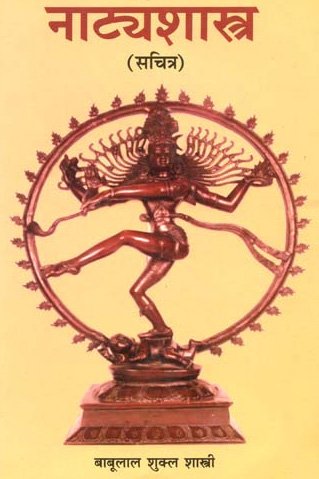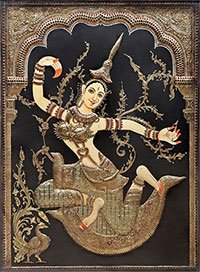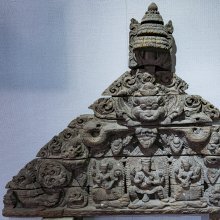Lina, Līna: 28 definitions
Introduction:
Lina means something in Buddhism, Pali, Hinduism, Sanskrit, Jainism, Prakrit, Marathi, Hindi. If you want to know the exact meaning, history, etymology or English translation of this term then check out the descriptions on this page. Add your comment or reference to a book if you want to contribute to this summary article.
Alternative spellings of this word include Leen.
Images (photo gallery)
In Hinduism
Natyashastra (theatrics and dramaturgy)
Source: Wisdom Library: Nāṭya-śāstraLīna (लीन).—One of the 108 karaṇas (minor dance movement) mentioned in the Nāṭyaśāstra chapter 4. The instructions for this līna-karaṇa is as follows, “the two Patāka hands held together in Añjali pose on the chest, the neck held high, and the shoulder bent.”.
A karaṇa represents a minor dance movements and combines sthāna (standing position), cārī (foot and leg movement) and nṛttahasta (hands in dancing position).
Source: Wisdom Library: SaṅgītaśiromaṇiLīna (लीन, “pressed”) refers to one of the fifteen aspects of gamaka (embellishments, ornamentation) that are used in Indian classical music (gāndharva), according to the Saṅgītaśiromaṇi 14.83-94. These gamakas refer to essential elements of the sthāyas (technical phrases) of rāgas (melodic modes). Accordingly, “a vibration (kampa) with the duration of a druta is caleld līna”.
Source: archive.org: Shanmukha 07-3-1981Lina (लिन).—“(The lina-gamaka refers to) the merging of a note softly into another note.” This kind of ‘glide’ can be found in both styles but its frequency is indisputably greater in Hindustani music than in the south. The habit of sliding from one note to another in imperceptible stages—what the northerners call the ‘meend’, is in fact a characteristic of aesthetic ecvellence in the Hindustani style. It is possible that the occasional use of the lina-gamaka became acceptable in the Carnatic style only in the lst few decades following greater exposure for, and appreciation of, Hindustani music in the Southern regions in the post-Independence years.
Source: archive.org: Northern Indian Music Volume ILīna (लीन).—Melting away (līna) refers to one of the gamakas (graces):—“The speed of līna is that of a quaver (druta = ½ mātrā)”. Saṅgītaratnākara 2.3.91 “When a note at the speed of a quaver softly melts into another neighbouring note this is called melting away (līna)”. (Saṅgītasamayasāra 1.51)
Source: Shodhganga: Elements of Art and Architecture in the Trtiyakhanda of the Visnudharmottarapurana (natya)Līna (लीन) [mentioned twice] refers to one of the 108 kinds of Karaṇa (“coordination of precise movements of legs and hands”), according to the Viṣṇudharmottarapurāṇa, an ancient Sanskrit text which (being encyclopedic in nature) deals with a variety of cultural topics such as arts, architecture, music, grammar and astronomy.—According to the Viṣṇudharmottarapurāṇa, karaṇas are the coordination of precise movements of legs and hands performed in a particular posture. The Nāṭyaśāstra also gives its view point in the same spirit. In the Viṣṇudharmottarapurāṇa, one hundred and eight kinds of karaṇas are accepted, e.g., Līna.

Natyashastra (नाट्यशास्त्र, nāṭyaśāstra) refers to both the ancient Indian tradition (shastra) of performing arts, (natya—theatrics, drama, dance, music), as well as the name of a Sanskrit work dealing with these subjects. It also teaches the rules for composing Dramatic plays (nataka), construction and performance of Theater, and Poetic works (kavya).
Shaktism (Shakta philosophy)
Source: Google Books: ManthanabhairavatantramLīna (लीन) refers to the “establishment of creation”, according to the Kaulajñānanirṇaya (traditionally attributed to Matsyendranātha), which references to the prototype of the Liṅga initiates of the Kubjikā Tantras worship in the Goddess’s maṇḍala which is projected above the head. Bhairava begins by listing a series of lotuses in the body. They are arranged vertically in such a way that each succeeding one has a larger number of petals than the one before it. [...] The last one consists of 30 million petals. There, above that, is a pervasive, eternally manifest (nityodita), unbroken, independent, unmoving, all-pervasive and stainless lotus. Emanation takes place by its will and it dissolves away (laya) there itself. Thus it is called Liṅga and is where the mobile and immobile (creation) is established (līna). [...]
Source: Brill: Śaivism and the Tantric Traditions (shaktism)Līna (लीन) refers to “dissolving” (into the state of the Goddess—Śārikā/Bhavānī), according to Sāhib Kaul’s Śārikāstrotra.—Accordingly, “[...] He who recites your syllable with pure heart and proper devotion, O Śārikā, which consists of abja and vaktravṛtta, in his mouth a fully developed voice stays, which has the beauty of unfolding through various good emotions. He who recites your syllable, consisting of abja and vaktravṛtta, and called asthyātmā, O Śārikā, is liberated in life and, enjoying supreme bhogas, will later dissolve (līna) in your state, O Bhavānī. [...]”.

Shakta (शाक्त, śākta) or Shaktism (śāktism) represents a tradition of Hinduism where the Goddess (Devi) is revered and worshipped. Shakta literature includes a range of scriptures, including various Agamas and Tantras, although its roots may be traced back to the Vedas.
Yoga (school of philosophy)
Source: ORA: Amanaska (king of all yogas): A Critical Edition and Annotated Translation by Jason BirchLīna (लीन) refers to “having dissolved (one’s mind)”, according to Bhāgavatotpala’s Spandapradīpikā on 31.—The ‘dissolution’ of the mind was a description of the meditative process itself, as seen for example in Bhāgavatotpala’s definition of meditation (dhyāna): “When the mind has dissolved (līna) in the object of meditation, then that is said to be meditation”.

Yoga is originally considered a branch of Hindu philosophy (astika), but both ancient and modern Yoga combine the physical, mental and spiritual. Yoga teaches various physical techniques also known as āsanas (postures), used for various purposes (eg., meditation, contemplation, relaxation).
Sports, Arts and Entertainment (wordly enjoyments)
Source: archive.org: Syainika Sastra of Rudradeva with English Translation (art)Līna (लीन) refers to “(several hunters) being jointly engaged (in hunting)”, according to the Śyainika-śāstra: a Sanskrit treatise dealing with the divisions and benefits of Hunting and Hawking, written by Rājā Rudradeva (or Candradeva) in possibly the 13th century.—Accordingly, “Hunting by lying in wait is that in which a bowman singly or jointly (līna) with others awaits the approach of animals and then pierces them with poisoned darts. It succeeds where there are trees of the Beleric myrobalan, in corn fields, and in places for drinking water, An easy success in killing lions and other ferocious animals is achieved by placing the carcass of a cow in a suitable position”.

This section covers the skills and profiencies of the Kalas (“performing arts”) and Shastras (“sciences”) involving ancient Indian traditions of sports, games, arts, entertainment, love-making and other means of wordly enjoyments. Traditionally these topics were dealt with in Sanskrit treatises explaing the philosophy and the justification of enjoying the pleasures of the senses.
Purana and Itihasa (epic history)
Source: archive.org: Shiva Purana - English TranslationLīna (लीन) refers to “becoming submerged”, according to the Śivapurāṇa 2.4.16 (“The head of Gaṇeśa is chopped off”).—Accordingly, as Brahmā narrated to Nārada: “[...] O sage, on seeing Viṣṇu in that manner, the two Śaktis handed over their power to Gaṇeśa and became submerged (līna). When the two Śaktis became submerged, Gaṇeśa with more strength infused in him hurled the iron club in the place where Viṣṇu stood. Viṣṇu strenuously dodged the same after remembering Śiva, the great lord, favourably disposed towards His devotees. [...]”.

The Purana (पुराण, purāṇas) refers to Sanskrit literature preserving ancient India’s vast cultural history, including historical legends, religious ceremonies, various arts and sciences. The eighteen mahapuranas total over 400,000 shlokas (metrical couplets) and date to at least several centuries BCE.
In Buddhism
Tibetan Buddhism (Vajrayana or tantric Buddhism)
Source: OSU Press: Cakrasamvara SamadhiLīna (लीन) refers to “(being) absorbed (in great bliss)”, according to the Cakrasaṃvara Samādhi [i.e., Cakrasamvara Meditation] ritual often performed in combination with the Cakrasaṃvara Samādhi, which refers to the primary pūjā and sādhanā practice of Newah Mahāyāna-Vajrayāna Buddhists in Nepal.—Accordingly, “Reflect, absorbed in great bliss (mahāsukha-līna). Therein vajra fire, lotus fire, blazing fire, Again Śumbha Niśumbha Hūṃ Phaṭ”.

Tibetan Buddhism includes schools such as Nyingma, Kadampa, Kagyu and Gelug. Their primary canon of literature is divided in two broad categories: The Kangyur, which consists of Buddha’s words, and the Tengyur, which includes commentaries from various sources. Esotericism and tantra techniques (vajrayāna) are collected indepently.
In Jainism
General definition (in Jainism)
Source: The University of Sydney: A study of the Twelve ReflectionsLīna (लीन) or Antarlīna refers to “sticking (within)” (i.e., ‘the mass of karmas time which is sticking within’), according to the 11th century Jñānārṇava, a treatise on Jain Yoga in roughly 2200 Sanskrit verses composed by Śubhacandra.—Accordingly, “The one who is doing good actions, whose conduct is pure, is engaged in external asceticism to such an extent and then there is the highest meditation which is abstaining from anything perceptible by the senses [and] resting in the self. He destroys the mass of karmas accumulated for a very long time which is sticking within (antarlīna) then he is immersed in the ocean of knowledge which is the abode of the highest bliss. [Thus ends the reflection on] wearing away karma”.

Jainism is an Indian religion of Dharma whose doctrine revolves around harmlessness (ahimsa) towards every living being. The two major branches (Digambara and Svetambara) of Jainism stimulate self-control (or, shramana, ‘self-reliance’) and spiritual development through a path of peace for the soul to progess to the ultimate goal.
Languages of India and abroad
Pali-English dictionary
Source: BuddhaSasana: Concise Pali-English Dictionarylīna : (pp. of līyati) shrunk; shy; reserved.
Source: Sutta: The Pali Text Society's Pali-English DictionaryLīna, (pp. of līyati) clinging, sticking; slow, sluggish; shy, reserved, dull, A. I, 3; Vism. 125. Definitions at Vbh. 352, 373; Dhs. 1156, 1236; S. V, 277, 279 (ati°). Often combined with uddhata as “sluggish or shy” and “unbalanced, ” e.g. at S. V, 112; Vism. 136; VbhA. 310. alīna active, open, sincere Sn. 68 (°citta), 717 (id.); J. I, 22 (v. 148; °viriya sīha). (Page 584)

Pali is the language of the Tipiṭaka, which is the sacred canon of Theravāda Buddhism and contains much of the Buddha’s speech. Closeley related to Sanskrit, both languages are used interchangeably between religions.
Marathi-English dictionary
Source: DDSA: The Molesworth Marathi and English Dictionarylīna (लीन).—a (S) Absorbed into; swallowed up in, lit. fig. 2 Humble, lowly, meek.
Source: DDSA: The Aryabhusan school dictionary, Marathi-Englishlīna (लीन).—a Absorbed into. Humble, lowly.
Marathi is an Indo-European language having over 70 million native speakers people in (predominantly) Maharashtra India. Marathi, like many other Indo-Aryan languages, evolved from early forms of Prakrit, which itself is a subset of Sanskrit, one of the most ancient languages of the world.
Sanskrit dictionary
Source: DDSA: The practical Sanskrit-English dictionaryLīna (लीन).—p. p. [lī-kta]
1) Clung or adhered to, stuck to.
2) Lurking, hid, concealed.
3) Resting or reclining on; कार्या सैकतलीनहंसमिथुना स्रोतोवहा मालिनी (kāryā saikatalīnahaṃsamithunā srotovahā mālinī) Ś.6.17.
4) Melted, dissolved; लीनेव प्रतिबिम्बितेव (līneva pratibimbiteva) ...... सा नश्चेतसि कीलितेव (sā naścetasi kīliteva) Mālatīmādhava (Bombay) 5.1.
5) Completely absorbed or swallowed up in, intimately united with; नद्यः सागरे लीना भवन्ति (nadyaḥ sāgare līnā bhavanti).
6) Devoted or given up to.
7) Disappeared, vanished; (see lī).
Source: Cologne Digital Sanskrit Dictionaries: Edgerton Buddhist Hybrid Sanskrit DictionaryLīna (लीन).—adj. (= Pali id.; not in this sense in Sanskrit; for true definition see Critical Pali Dictionary s.v. alīna, q.v.; wrongly Childers and [Pali Text Society’s Pali-English Dictionary]), dispirited, faint-hearted: Mahāvyutpatti 7269 = Tibetan zhum pa; 850 apagata-līna-citta (of Bodhisattvas); Śikṣāsamuccaya 20.15 līnaṃ cittaṃ bodhisattvānāṃ na saṃvidyate. Cf. 2 līyati.
Source: Cologne Digital Sanskrit Dictionaries: Shabda-Sagara Sanskrit-English DictionaryLīna (लीन).—mfn.
(-naḥ-nā-naṃ) 1. Embraced, clung or adhered to. 2. Melted, dissolved. 3. Dissolved with softness, overcome with passion. 4. Diffused. 5. Effaced, wiped away, vanished. 6. Staying, being situated. 7. Left, departed. 8. Lurking, hiding. 9. Resting on. 10. Absorped, swallowed up. 11. Devoted to. E. lī to be in contact, &c., kta aff.
Source: Cologne Digital Sanskrit Dictionaries: Cappeller Sanskrit-English DictionaryLīna (लीन).—[adjective] clinging or sticking to ([neuter] also as [abstract] [with] [locative]), lying or sitting on, quite devoted to or intent upon; ([neuter] also [impersonally]) hidden, absorbed, or disappeared into ([locative] or —°). Abstr. tā [feminine], tva [neuter]
Source: Cologne Digital Sanskrit Dictionaries: Monier-Williams Sanskrit-English Dictionary1) Līna (लीन):—[from lī] mfn. clung or pressed closely together, attached or devoted to, merged in ([locative case] or [compound]), [Rāmāyaṇa; Sarvadarśana-saṃgraha]
2) [v.s. ...] sticking, [Mahīdhara]
3) [v.s. ...] lying or resting on, staying in, lurking, hiding, [Mahābhārata; Kāvya literature] etc.
4) [v.s. ...] dissolved, absorbed in ([locative case] or [compound]), disappeared, vanished, [Śvetāśvatara-upaniṣad; Mahābhārata] etc.
5) [v.s. ...] n. the clinging to, being dissolved or absorbed in, disappearance, [Pañcarātra]
Source: Cologne Digital Sanskrit Dictionaries: Yates Sanskrit-English DictionaryLīna (लीन):—[(naḥ-nā-naṃ) p.] Melted; embraced; absorbed in; left.
Source: DDSA: Paia-sadda-mahannavo; a comprehensive Prakrit Hindi dictionary (S)Līna (लीन) in the Sanskrit language is related to the Prakrit word: Līṇa.
[Sanskrit to German]
Sanskrit, also spelled संस्कृतम् (saṃskṛtam), is an ancient language of India commonly seen as the grandmother of the Indo-European language family (even English!). Closely allied with Prakrit and Pali, Sanskrit is more exhaustive in both grammar and terms and has the most extensive collection of literature in the world, greatly surpassing its sister-languages Greek and Latin.
Hindi dictionary
Source: DDSA: A practical Hindi-English dictionaryLīna (लीन) [Also spelled leen]:—(a) absorbed, engrossed; merged; vanished, disappeared; hence ~[tā] (nf).
...
Prakrit-English dictionary
Source: DDSA: Paia-sadda-mahannavo; a comprehensive Prakrit Hindi dictionaryLīṇa (लीण) in the Prakrit language is related to the Sanskrit word: Līna.
Prakrit is an ancient language closely associated with both Pali and Sanskrit. Jain literature is often composed in this language or sub-dialects, such as the Agamas and their commentaries which are written in Ardhamagadhi and Maharashtri Prakrit. The earliest extant texts can be dated to as early as the 4th century BCE although core portions might be older.
Kannada-English dictionary
Source: Alar: Kannada-English corpusLīna (ಲೀನ):—
1) [adjective] clung to; adhered to; attached to.
2) [adjective] merged in a liquid; dissolved.
3) [adjective] absorbed, engrossed in.
4) [adjective] hidden or disappeared; got out of sight.
--- OR ---
Līna (ಲೀನ):—
1) [noun] a man who is deeply interested, engrossed or absorbed in.
2) [noun] the fact of being absorbed, engrossed in.
3) [noun] a particular kind of regulated vibration of a note.
4) [noun] (dance.) one of the one hundred and eight gesticulations of hands.
Kannada is a Dravidian language (as opposed to the Indo-European language family) mainly spoken in the southwestern region of India.
See also (Relevant definitions)
Starts with (+8): Lina-mudra, Linabira, Linacitta, Linadina, Linali, Linambatata, Linanthus ciliatus, Linanthus floribundus, Linanthus nuttallii, Linaria bipartita, Linaria spuria, Linaria vulgaris, Linariantha bicolor, Linarthavada, Linarthavicara, Linata, Linate, Linatog-anat, Linatta, Linatthadipani.
Ends with (+246): A-candra-arka-arnava-kshiti-sarit-parvata-sama-kalina, A-candra-arka-arnava-kshiti-sthiti-sama-kalina, Abhilina, Achillea santolina, Adhyakulina, Adikalina, Ailina, Ajuga lupulina, Akakolina, Akalina, Akilina, Akulina, Alina, Allina, Alpakalina, Alpinia vitellina, Amalina, Amelina, Amtahkalina, Amtahkaranamalina.
Full-text (+56): Linata, Alina, Antarlina, Lahina, Pralinata, Antalina, Vilina, Nilina, Li, Gvala, Linatva, Nailinaka, Liya, Samlinamanasa, Samlinakarna, Vilinashatpada, Pralina, Prakkalina, Svarlina, Lina-mudra.
Relevant text
Search found 17 books and stories containing Lina, Līna, Līṇa; (plurals include: Linas, Līnas, Līṇas). You can also click to the full overview containing English textual excerpts. Below are direct links for the most relevant articles:
Garga Samhita (English) (by Danavir Goswami)
Verse 2.6.7 < [Chapter 6 - The Liberation of Aghāsura]
Verse 5.9.26 < [Chapter 9 - The Happiness of the Yadus]
Verse 5.10.3 < [Chapter 10 - The Stories of the Washerman, Weaver, and Florist]
Brihad Bhagavatamrita (commentary) (by Śrī Śrīmad Bhaktivedānta Nārāyana Gosvāmī Mahārāja)
Verse 1.4.28 < [Chapter 4 - Bhakta (the devotee)]
Verse 2.2.98-99 < [Chapter 2 - Jñāna (knowledge)]
Bhakti-rasamrta-sindhu (by Śrīla Rūpa Gosvāmī)
Verse 4.8.48 < [Part 8 - Compatible & Incompatible Mellows (maitrī-vaira-sthiti)]
Verse 3.1.42 < [Part 1 - Neutral Love of God (śānta-rasa)]
Vishnudharmottara Purana (Art and Architecture) (by Bhagyashree Sarma)
2.5. Karaṇa (movements of legs and hands) < [Chapter 3 - Drama and Dance]
Abhinaya-darpana (English) (by Ananda Coomaraswamy)
Chapter 15 - Twenty-seven Combined Hands
Chapter 28 - Hands denoting Water Creatures
Chaitanya Bhagavata (by Bhumipati Dāsa)
Verse 2.7.136 < [Chapter 7 - The Meeting of Gadādhara and Puṇḍarīka]
Verse 3.4.246 < [Chapter 4 - Descriptions of Śrī Acyutānanda’s Pastimes and the Worship of Śrī Mādhavendra]
Verse 3.10.182 < [Chapter 10 - The Glories of Śrī Puṇḍarīka Vidyānidhi]



